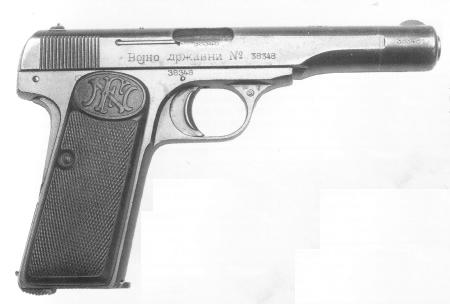
The FN Historical Society Inc - - - - - - This site is being phased out and will no longer be updated after November 2015 Please see our new site at The F.N. Historical Society Inc. Lingea lexicon 5 platinum keygen.
Historic Firearm of the Month, May 2001 CRUFFLER.COM presents HISTORIC FIREARM OF THE MONTH, May 2001: The FN Browning Model 1922 Pistol Type: Self Loading Pistol System of Operation: Blowback Caliber: 7.65mm Browning or 9mm Browning Short Capacity: 8 round box magazine Sights front: Blade Sights, rear: Adjustable aperture Length: 7.01' Weight (loaded): 25.7 ozs Barrel: 4.5', 6 grooves, right hand twist HISTORY The Fabrique Nationale (FN) Browning Model 1922 pistol bears the distinction of being developed strictly at the request of a FN customer. Specifically, the 'Kingdom of Serbs, Croats and Slovenes' (later known as Yugoslavia) which had been created out of the ashes of the Austro-Hungarian Empire. In the early 1920's the Yugoslav military was in a shambles. Its constituent entities had fought the Balkan wars of 1912 and 1913, then the First World War. The arsenals were empty, and the army devoid of war materiel.
The Model 1910 FN Browning was manufactured from 1912 through 1975. Production was halted during the two World Wars, though a few were assembled from parts during the German occupation in World War II. There was no interruption in serial numbers.
The Serbs, forming the majority of the new Yugoslav state, had been an important FN client since the beginning of the firm, in the 1880's, and decided to turn to the Belgian firm for their war materiel needs. Initial considerations for the new Yugoslav service handgun were the FN Models 1903 and 1910. The Model 1903 was rejected as being too expensive. The Model 1910 gained favor because of its relatively economical pricing and 9mm Browning Short cartridge. While the Model 1910 performed well in the evaluations, it had some shortcomings as a military pistol. The Yugoslavs requested a longer barrel conducive to greater accuracy, as well as increased magazine capacity.
The design problem was turned over to the FN Bureau d'Etudes (Research and Development Office). The Bureau d'Etudes took stock of the situation. The Yugoslavs certainly couldn't afford the expense of developing and tooling for a new pistol. Consequently, a series of modifications to the Model 1910 were proposed that would save considerably on tooling and start up production costs. A forged steel cap was added to the 1910 slide in order to accommodate the longer (113mm as opposed to the 1910's 88mm) barrel. The frame was lengthened to accommodate the longer magazine.
A lanyard ring was added. The engineering was complete by 1922, and the Yugoslavs placed an order for 60,000 pistols on February 28, 1923. FN M1910 Pistol Image Credit: Vanderlinden, Anthony, The Belgian Browning Pistols, Wet Dog Publications, Greensboro, North Carolina, 2001: Page 129 It must be noted that the changes to the 1910 design were incremental.
Initial experiments were made with pistols that retained the frame of the 1910 mated with a new slide, followed by a frame that held a seven instead of eight round magazine. Eventually, the design was finalized, and production began. Production serial numbers started at approximately 200,000. (Note: All prewar Model 1922's with serial numbers below 200,000 show contract serial number ranges, while those with serial numbers above 200,000 display standard FN production serial numbers. Serialization was restarted after the liberation in 1944.
OPERATION The M1922 is a blowback operated pistol; there is no mechanical lock between the slide and barrel. Instead, the breech is held closed by a combination of the mass of the slide and a stout recoil spring.
Operation of the pistol is as follows: A loaded magazine is inserted into the butt, and the slide drawn to the rear. When the slide is released, it moves forward under pressure of the recoil spring and strips a round from the magazine into the chamber, retaining the cartridge's rim under the externally mounted extractor. When the slide is drawn to the rear, the striker is also pulled to the rear, compressing the striker spring. When the slide is drawn to the rearmost position, the striker's nose rides over, and is retained by the sear. Image Credit: Hogg, Ian and John Weeks, Pistols of the World, 3rd Edition, DBI Books, Inc., Northbrook, Illinois,1992: Page 66 When the trigger is pressed, the trigger bar presses against the sear, rotating it back and down. This frees the striker to move forward and fire the chambered round. Upon firing, the case moves sharply rearward, imparting rearward motion to the slide.
Hey guys this is how to get medieval 2 total war hope it will work for you make sure you subscribe for more videos and feel free to suggest any game links are in here. 